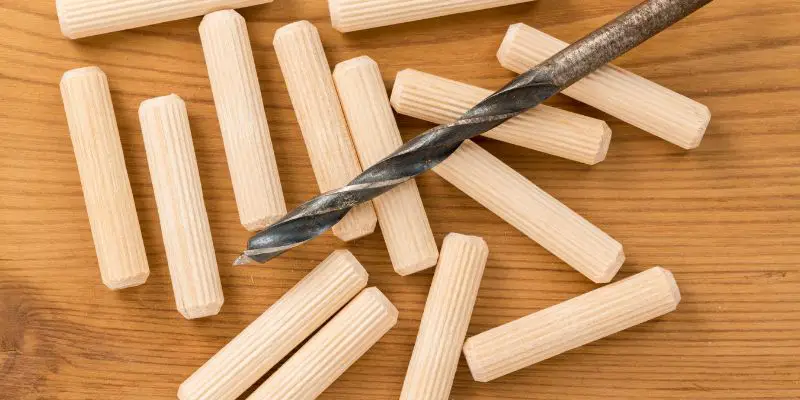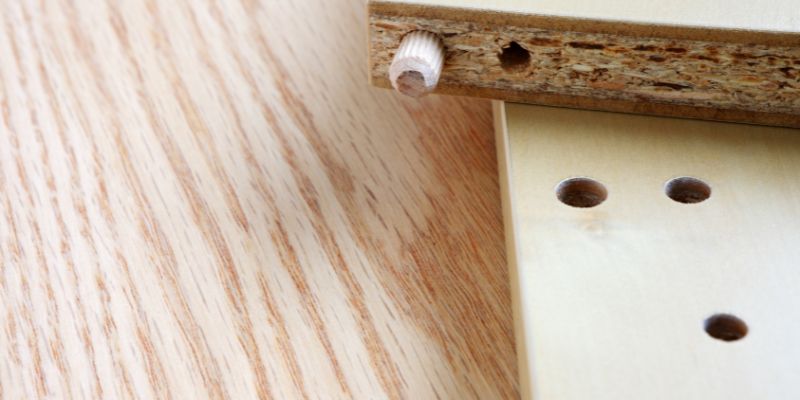To cut dowels, use a sharp handsaw or a dowel-cutting jig. First, mark the desired length of the dowel, then secure it in place.
Use steady, controlled strokes to cut through the dowel. Cutting dowels can be easily accomplished using a sharp handsaw or a dowel-cutting jig. These tools enable you to accurately trim dowels to the desired length. Before cutting, ensure the dowel is securely fastened to prevent any unnecessary movement.
By employing steady and controlled strokes, you can confidently cut through the dowel, achieving precise results. Whether you are working on a woodworking project or any other task that requires dowel cutting, employing these techniques will enable you to complete the task efficiently and effectively.
Choosing The Right Dowel Cutter
To ensure you cut dowels with precision, it’s crucial to select the right dowel cutter. Look for a cutter with a sharp blade and adjustable sizing to meet your specific needs. Choose a high-quality cutter to achieve clean and accurate results.
When it comes to cutting dowels, choosing the right dowel cutter is crucial in achieving clean and precise cuts. The right tool will not only make the process easier but also ensure that your dowels are cut to the desired size and shape. Consider the following factors when selecting the perfect dowel cutter for your woodworking projects.
Consider The Size And Type Of Dowel
Before delving into the market to buy a dowel cutter, it’s important to consider the size and type of dowel you’ll be working with. Dowel cutters come in various sizes to accommodate different dowel diameters. Ensure that the cutter you choose is compatible with the specific size of dowels you intend to cut. Additionally, there are different types of dowels, such as fluted, spiral, or straight, and each may require a different type of cutter. Be sure to choose a dowel cutter that matches the type of dowel you’ll be working with.

Evaluate The Quality And Durability
When investing in a dowel cutter, quality, and durability should be key factors in your decision-making process. You want a tool that will withstand repeated use and produce clean and precise cuts every time. Look for dowel cutters made from high-quality materials such as hardened steel or carbide. These materials are known for their strength and longevity. Read customer reviews and consider the reputation of the brand to ensure that you are getting a reliable and durable dowel cutter.
Consider Ease Of Use And Safety Features
A good dowel cutter should be easy to use, even for beginners. Look for a cutter with ergonomic handles that provide a comfortable grip and reduce strain on your hands. Additionally, safety should always be a priority when working with any kind of cutting tool. Check if the dowel cutter has safety features such as blade guards or locking mechanisms that prevent accidents during operation. Prioritize your safety and choose a dowel cutter that offers adequate protection.
Price And Budget Considerations
While you want to invest in a high-quality dowel cutter, it’s also important to consider your budget. Set a budget range before you start shopping around, and compare prices from different suppliers. Keep in mind that the most expensive cutter might not always be the best one for your needs, and a reasonably priced option might deliver great results. Look for sales or discounts to get a good deal without compromising on quality.
In conclusion, choosing the right dowel cutter is crucial for achieving clean and precise cuts. Consider the size and type of dowel you’ll be working with, evaluate the quality and durability of the cutter, ensure ease of use and safety features, and take your budget into account. By considering these factors, you can select the perfect dowel cutter for your woodworking projects.
Preparing The Wood For Cutting
Cutting dowels is an essential skill for woodworking projects. Before you start cutting, it’s important to properly prepare the wood to ensure accurate and clean cuts. In this section, we will cover selecting the appropriate wood as well as proper wood measurement and marking.
Selecting The Appropriate Wood
Choosing the right wood for your dowels is crucial for a successful cutting process. You’ll want to consider factors such as the type of project you’re working on, the wood’s strength, and its grain direction.
-
- Consider the project:
Think about the specific requirements of your project. Are you building furniture or crafting smaller decorative items? For furniture, you’ll need stronger, more durable wood, while decorative items may allow for softer wood.
-
- Evaluate the wood’s strength:
Each wood species has different levels of strength and hardness. Hardwoods such as oak and maple are ideal for projects that require durability and stability, while softwoods like pine and cedar work well for less demanding applications.
-
- Analyze the grain direction:
The grain direction of the wood affects cut quality and integrity. Look for woods with straight and consistent grain lines, as these are easier to work with and less likely to split during cutting.
Proper Wood Measurement And Marking
Accurate measurement and marking are crucial for cutting dowels to the desired lengths. Follow these steps to ensure precise cuts:
-
- Measure twice, cut once:
Take your time to measure the required length of the dowel twice using a tape measure or ruler. This double-checking helps prevent unnecessary mistakes and wasted wood.
-
- Mark the measurement:
Once you’ve determined the correct length, mark it on the wood using a pencil or a marking knife. Make sure the mark is clear and visible.
-
- Consider safety:
Wear safety goggles and gloves when you mark the wood to protect yourself from potential injuries.
In summary, to prepare the wood for cutting dowels effectively, select the appropriate wood based on your project requirements, evaluate the wood’s strength, and analyze the grain direction. Additionally, ensure accurate measurements by measuring twice and marking the intended length on the wood. Remember to prioritize your safety during these preparations.
Mastering The Cutting Technique
Cutting dowels with precision is an essential skill for woodworking projects. Mastering the cutting technique involves understanding the grain direction and using the dowel cutter safely. By following these guidelines, you can ensure clean and accurate cuts for your woodworking endeavors.
Understanding The Grain Direction
It’s imperative to comprehend the grain direction of the dowel before making any cuts. The grain direction dictates how the wood fibers are aligned and significantly impacts the ease and quality of the cut. Always examine the dowel closely to identify the direction of the grain before proceeding with the cutting process.
Using The Dowel Cutter Safely
When using a dowel cutter, safety should be a top priority. Ensure that the cutter is securely clamped to a stable surface to prevent any accidents. Wear protective gear such as safety goggles and gloves to safeguard yourself from wood chips and debris during the cutting process. Always adhere strictly to the manufacturer’s instructions and operate the cutter with caution.
Fine-tuning And Smoothing The Dowels
Once you’ve trimmed and shaped the dowel ends, it’s time to focus on fine-tuning and smoothing them to achieve a professional finish. This crucial step ensures that your dowels fit seamlessly into their designated holes and that they have a smooth, polished appearance.
Trimming And Shaping The Dowel Ends
Before moving on to the fine-tuning process, it is important to ensure that the dowel ends are properly trimmed and shaped. Here’s how you can achieve this:
- Use a sharp saw or a dowel-cutting tool to trim the dowel ends to the desired length, making sure they are perpendicular to the dowel’s length.
- If necessary, use sandpaper or a file to shape the trimmed ends. This will ensure that they fit precisely into the designated holes.
- Once you’re satisfied with the shape and length of the dowel ends, it’s time to move on to the fine-tuning process.
Sanding And Polishing For A Professional Finish
To achieve a polished, professional finish for your dowels, follow these steps:
- Start by sanding the entire surface of the dowels with a medium-grit sandpaper. This will help smooth out any rough edges or imperfections.
- Gradually move on to finer-grit sandpapers to achieve a smoother finish. Be sure to sand in the direction of the grain to avoid splintering the wood.
- After sanding, wipe away any dust or debris from the dowels using a clean cloth or a tack cloth.
- Apply a thin coat of wood polish or varnish to the dowels, using a brush or a cloth. This will enhance the natural beauty of the wood and provide a protective layer.
- Allow the polish or varnish to dry according to the manufacturer’s instructions before handling or installing the dowels.
By following these steps, you can ensure that your dowels not only fit perfectly but also have a professional, polished appearance. This attention to detail and fine-tuning is what sets your woodworking projects apart and brings them to a whole new level of craftsmanship.
Troubleshooting And Tips
Learn how to efficiently cut dowels with these troubleshooting tips. Master the techniques to ensure clean and precise cuts every time.
Dealing With Splintering Or Rough Edges
When cutting dowels, it’s not uncommon to encounter splintering or rough edges that can mar the finish or affect the overall fit. Luckily, there are some simple steps you can take to minimize these issues and ensure a clean, professional result.
First and foremost, using the right cutting tools can make a world of difference. A sharp handsaw or a dowel cutter specifically designed for this purpose can help prevent splintering and achieve cleaner cuts. Always make sure your blades are sharp and in good condition before starting.
Another tip is to score the surface of the dowel before cutting. This can be done by running a sharp utility knife along the line where you plan to make the cut. Scoring helps to prevent the wood from splintering when the saw blade makes contact.
If you still encounter splintering despite these precautions, you can try wrapping the area where you plan to cut it with masking tape. This can help hold the wood fibers together and reduce the likelihood of splintering.
| Quick Tips to Deal with Splintering or Rough Edges: |
| – Use sharp cutting tools such as a handsaw or a dowel cutter |
| – Score the surface of the dowel with a utility knife before cutting |
| – Try wrapping the area with masking tape to prevent splintering |
Expert Tips For Perfect Dowel Cutting
To achieve flawless dowel cuts, consider implementing these expert tips that can make all the difference:
- Take your time and go slow. Rushing through the cutting process increases the likelihood of mistakes and uneven cuts.
- Secure the dowel firmly in place before making any cuts. This can be done by using clamps or a vise to hold the dowel steady.
- Measure twice and cut once. Double-check your measurements to ensure accuracy before making any cuts.
- Use a miter box or a cutting jig to hold the dowel at the desired angle. This can help you achieve precise and consistent cuts, especially when working on angled dowels.
- Consider sanding the ends of the dowels after cutting. This can help remove any rough edges or imperfections for a smoother fit.
- Apply a small amount of wood glue to the end of the dowel before inserting it into the hole. This can provide added strength and stability to your joinery.
By following these expert tips, you’ll be well on your way to achieving perfectly cut dowels that fit seamlessly into your woodworking projects.

Frequently Asked Questions Of How To Cut Dowels
What Is The Best Tool For Cutting A Dowel?
The best tool for cutting a dowel is a dowel cutter. It provides precise and clean cuts, ensuring accuracy in your woodworking projects. Use a dowel cutter to trim dowels to your desired length effortlessly.
What Do You Cut Wooden Dowels With?
You can cut wooden dowels with a saw or a sharp knife. Sawing is the most common and efficient method.
How Do You Cleanly Cut Dowels?
To cleanly cut dowels, follow these steps:
1. Mark the desired location for the cut on the dowel.
2. Use a sharp saw, handsaw, or miter saw to carefully cut along the marked line.
3. Apply consistent pressure while cutting to ensure a clean, even cut.
4. Sand the cut end of the dowel to smooth out any rough edges.
5. Remember to wear safety goggles and gloves for protection while cutting.
What Saw Is Used To Cut Dowels?
A coping saw is commonly used to cut dowels. It is best suited for making fine, curved cuts with precision.
Conclusion
Learning how to cut dowels can be a valuable skill for DIY enthusiasts and professionals alike. With the right tools and techniques, you can achieve precise and clean cuts, enhancing the quality of your woodworking projects. By following the tips and methods outlined in this guide, you can confidently tackle dowel cutting with ease and efficiency.


